Cobalt to Share EV Battery Duties with Nickel
Commodities / Electric Cars Jul 28, 2019 - 03:20 PM GMTBy: Richard_Mills
 In the spring of 2018 Tesla came out with a bold prediction: bringing the amount of cobalt used in their Model 3 battery cells down to zero.
In the spring of 2018 Tesla came out with a bold prediction: bringing the amount of cobalt used in their Model 3 battery cells down to zero.
“Cells used in Model 3 are the highest energy density cells used in any electric vehicle. We have achieved this by significantly reducing cobalt content per battery pack while increasing nickel content and still maintaining superior thermal stability,” the company stated in its Q1 2018 update letter. “The cobalt content of our Nickel-Cobalt-Aluminum cathode chemistry is already lower than next-generation cathodes that will be made by other cell producers with a Nickel-Manganese-Cobalt ratio of 8:1:1,” Tesla boasted.
In the quest to reduce input costs, be socially responsible and to provide longer driving ranges, like Tesla, those other cell producers are wanting to reduce the amount of cobalt used in their EV batteries and increase the content of nickel. Typically EV batteries use NCA or NMC type lithium-ion - 60% of the world’s cobalt supply comes from the DRC where mining it is controversial.
Tesla is ahead of its competitors with respect to this switch. The company only uses 5% cobalt in their electric vehicle battery metals (the Model 3 uses 2.8% cobalt) versus 30% across the industry (eg. four times less than Volkswagen).
In a conference call with analysts, CEO Elon Musk went further, equivocating, “Yeah we think we can get the cobalt use to almost nothing.”
Reducing the amount of cobalt in the batteries has become an obsession for EV makers as they try to position themselves as both affordable and morally correct. The critical mineral is mined almost exclusively in the DRC, then shipped to China, which processes about 60% of the world’s cobalt into useful products, like cobalt hydroxide employed in EV battery cathodes.
Persistent reports of child labor and horrific working conditions prompted BMW to announce it will not purchase any more cobalt from the DRC. Apple has said it wants to buy cobalt directly from the mining companies, and Volkswagen is among car-makers that are insisting suppliers adhere to strict guidelines to ensure its products have a “clean” origin.
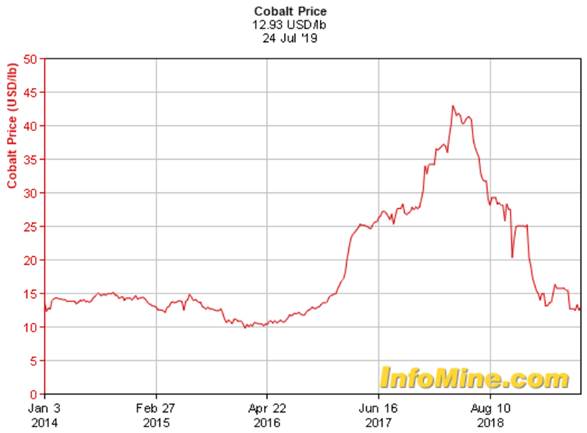
The mighty dollar of course is equally if not more of a reason to avoid cobalt. Between 2013 and 2018 prices tripled, from $15 a pound to $45/lb. And while 2019 has seen prices slump, due to miners over-producing to take advantage of earlier high prices, Roskill expects cobalt to recover later this year because of a steep 70% drop in artisanal mining production, AOTH reported last week.
The cobalt-reduction theme, then, will likely continue, and nickel is widely expected by the industry to be the beneficiary.
Once mined almost exclusively for its use in stainless steel, the industrial metal has enjoyed a kind of rebirth since battery-makers started using it in electric vehicles. According to Adamas Intelligence, which tracks battery metals, EV manufacturers deployed 57% more nickel in EV batteries this past May, versus May 2018. MINING.com reports nickel’s inroads are due mainly to an industry shift towards “ NMC 811” batteries which require over 50 kg of nickel - eight times the other metals in the battery. (first-version NMC 111 batteries have one part each nickel, cobalt and manganese)
If cobalt prices continue to rise, and we see so reason why they shouldn’t, with DRC/ China having a virtual monopoly, and the growth of electric vehicles compounding every year, substitution for cobalt by nickel will continue.
But to think that switching from Co to Ni will be easy for mining companies, battery-cos and automakers, is to fundamentally misunderstand the nickel market. In this article, we set out to prove that cobalt is not going anywhere, anytime soon, and that identifying, exploring and eventually mining enough battery-grade nickel to meet the demand, is fraught with problems. Before we explain why, here’s a primer on nickel.
Nickel uses
Nickel is present in over 3,000 different alloys, used in over 300,000 products for consumer, industrial, military, transportation, marine and architectural applications.
Nickel’s biggest use, about 65%, is in alloying - particularly with chromium and other metals to produce stainless and heat-resisting steels.
Another 20% is used in other steels, non-ferrous alloys (mixed with metals other than steel) and super alloys (metal mixtures designed to withstand extremely high temperatures and/or pressures, or have high conductivity) often for highly specialized industrial, aerospace and military applications.
About 9% is used in plating to slow down corrosion and 6% is for other uses, including printing coins. Rechargeable nickel-hydride batteries are used in cell phones, video cameras, and other electronic devices. Nickel-cadmium batteries are used to power cordless tools and appliances.
In many of these applications there is no substitute for nickel without reducing performance or increasing cost.
Most recently, nickel sulfate powder made from nickel sulfide ore, is a crucial ingredient in cathode formulation for lithium-ion batteries needed to propel electric vehicles.
Laterites vs sulfides
Nickel deposits come in two forms: sulfide or laterite. About 60% of the world's known nickel resources are laterites. The remaining 40% are sulfide deposits.
Generally sulfide deposits are found in more politically stable jurisdictions (eg. Canada, Australia, Greenland) than the often equatorial areas hosting laterite deposits, such as Indonesia, the Philippines, Papua New Guinea, New Caledonia and parts of Africa.
Sulfide deposits
Nickel sulfide deposits, of which the principal mineral is pentlandite, are formed when hydrothermal fluids precipitate nickel minerals. Sulfide deposits are also called magmatic sulfide deposits. The main benefit of sulfide ores is that they can be concentrated using a simple separation technique called flotation. Most nickel sulfide deposits have traditionally been processed by concentration, through a froth flotation process followed by pyrometallurgical (smelting) extraction.
Sulfide minerals require much less energy to liberate nickel from, meaning processing costs are much lower than laterite nickel deposits.
There are two main types of nickel sulfide deposits. In the first, Ni-Cu sulfide deposits, nickel (Ni) and copper (Cu) are the main economic commodities - copper may be either a co-product or by-product, and cobalt (Co), platinum group elements (PGE) and gold (Au) are the usual by-products.
The second type of deposit is mined exclusively for PGEs with the other associated metals as by-products. This includes the Bushveld Complex in South Africa.
Nickel sulfide deposits can occur as individual sulfide bodies, or groups of deposits that may occur in districts tens or even hundreds of kilometers long. Two giant Ni-Cu districts stand out above all the rest in the world: Sudbury, Ontario, and Noril’sk-Talnakh, Russia.
An important aspect of exploring for nickel in sulfide ores, is nickel tenor.
Nickel tenor is a reflection of how much nickel is in the sulfides as a percentage of that sulfide. If you have nickel tenor of 6% and you have 50% sulfide in your deposit, you are going to have 3% nickel.
When looking for a nickel deposit, or even better a nickel camp, you need to have evidence of a large, long-lasting magmatic event, and then you can start looking for nickel tenor.
Laterite deposits
Nickel laterite deposits were first discovered in 1864 by French civil engineer Jules Garnier in New Caledonia; commercial production started in 1875. The South Pacific island’s laterites were the world’s largest source of nickel until Sudbury, Ontario’s sulfide deposits started producing in 1905, and thereafter, totally dominated global production.
Laterite ores tend to be clustered near the equator.
In nickel laterite deposits, the principal minerals are nickeliferous limonite and garnierite. They are formed from the weathering of ultramafic rocks and are usually extracted from open pit mines. There is no simple separation technique for nickel laterites. As a result, laterite projects have high capital costs and therefore require large economies of scale to be viable. They will often sit for year or decades, undeveloped, waiting for higher nickel prices.
Roughly 60% of global nickel is locked in laterite deposits. The nickel content becomes strongly enriched in the course of lateritization. Under tropical conditions fresh rock weathers quickly. Some metals may be leached away by the weathering process but others, such as aluminum, iron and nickel, remain.
Typically nickel laterites are large-tonnage and low-grade deposits, located close to the surface. They tend to be tabular and flat covering many square kilometers. They are most often in the range of 20 million tonnes and upwards, with some examples approaching a billion tonnes of material.
In comparison, nickel sulfide deposits are usually, but not always, found underground and are more expensive and difficult to mine (but not to process). However, they typically carry a much higher grade than nickel laterites which more than offsets the extra cost of underground mining.
Laterite deposits usually contain both an upper dark red limonite (higher in iron and lower in nickel, magnesium and silica) and lower bright green saprolite zone (higher nickel, magnesium and silica but lower iron content). Due to the different quantities of iron, magnesium and silica in each zone, they must be processed differently to cost-effectively retrieve the nickel.
Laterite saprolite (higher nickel, magnesium and silica but lower iron content) orebodies are processed with standard pyrometallurgical technology.
However, a laterite limonite zone is higher in iron and lower in nickel, magnesium and silica, which means using High Pressure Acid Leaching (HPAL) technology to extract the nickel.
HPAL - whose performance record has been highly mixed - involves processing ore in a sulfuric acid leach at temperatures up to 270ºC and pressures up to 600 psi to extract the nickel and cobalt from the iron-rich ore; the pressure leaching is done in titanium-lined autoclaves.
Counter-current decantation is used to separate the solids and liquids. Separating and purifying the nickel/cobalt solution is done by solvent extraction and electrowinning.
The advantage of HPAL is its ability to process low-grade nickel laterite ores, and recover nickel and cobalt. However, HPAL is unable to process high-magnesium or saprolite ores, it has high maintenance costs due to the sulfuric acid, and it comes with the cost, environmental impact and hassle of disposing of the magnesium sulfate effluent waste.
According to S&P Global Market Intelligence, technical difficulties, high costs and low nickel prices in recent years led to problems at several HPAL projects, including the First Quantum Minerals’ Ravensthorpe mine, put into care and maintenance, Sherritt International having to write down CAD$1.723 billion of its Ambatovy mine, and Vale reviewing its Goro operation in New Caledonia.
Nickel market
Historically, most nickel was produced from sulfide ores, including the giant (>10 million tonnes) Sudbury deposits in Ontario, Norilsk in Russia and the Bushveld Complex in South Africa, known for its platinum group elements (PGEs). However, existing sulfide mines are becoming depleted, and are not being replaced, which has changed the geographical weighting of nickel production.
Russia, Canada and Australia used to be the top three nickel producers, but the rankings have changed significantly, as the table below shows. (this is what I predicted would happen, that sulfide exploration and production would gradually move from northern-hemisphere nickel sulfides to tropical-zone nickel laterites, when I extensively researched nickel back in 2012)
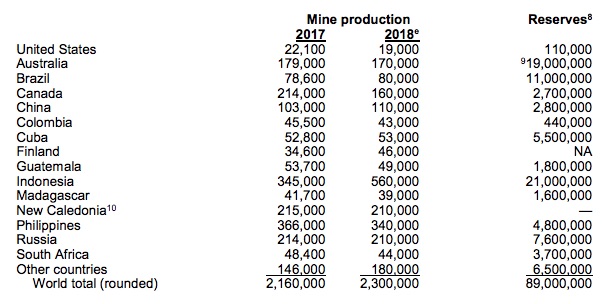
According to the US Geological Survey, in 2018 the top producer was Indonesia, followed by the Philippines, New Caledonia and Russia (tied), Australia and Canada.
The top five countries with the most nickel reserves are, in order, Indonesia, Australia, Brazil, Russia, and the Philippines. Of identified nickel resources, averaging 1% nickel or greater, there are at least 130 million tons with about 60% in laterites and 40% in sulfide deposits, states the USGS.
Only one nickel sulfide deposit has been discovered in the past decade, Nova-Bollinger in Western Australia which is now in production. A precipitous 86% drop in nickel prices between 2007 and 2016 slashed exploration budgets.
Due to a dearth of new nickel sulfide discoveries, mining companies have shifted exploration efforts to more remote, riskier locations in search of laterite ores, such as Africa and the subarctic.
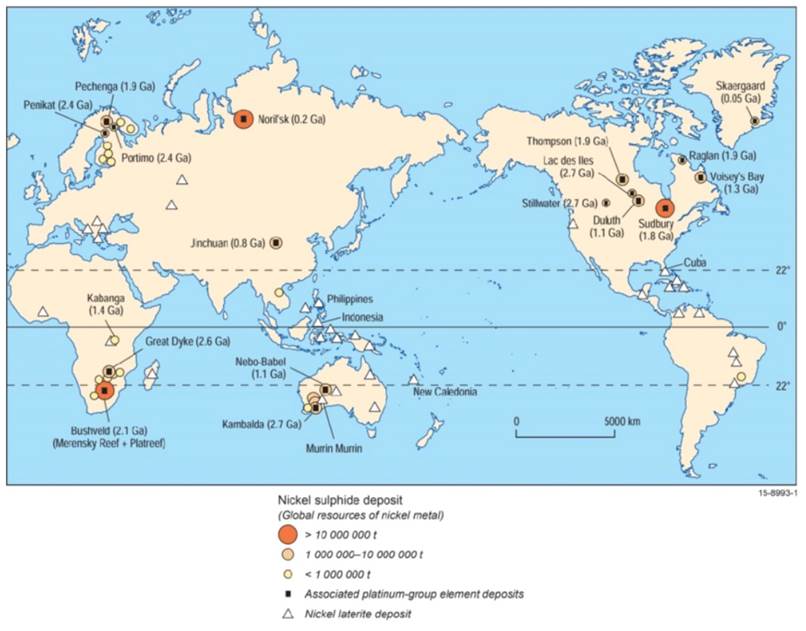
Security of supply is far greater an issue in the southern-latitude nickel deposits than in the northern-latitude sulfide belts.
Indonesia, the world’s top nickel producer, in 2012 enacted an export tax system, under which a 20% export tax was levied on 14 ores of Indonesian origin, including nickel. The result was to drive hundreds of small miners out of business and send Chinese laterite buyers elsewhere. The ban was in place from 2014-2016 and lifted in 2017.
Indonesia has said it will re-instate the ban on ore exports, starting in 2022, to encourage the building of domestic smelters. The costs however of building local refineries for processing bauxite (the aluminum mineral) and nickel, the main targets of the ban, are cost-prohibitive, as Indonesia found during its last metal export ban.
One of the biggest problems is a lack of electricity to service such large consumers of power as refineries. Some 20% of Indonesia quarter-billion population has no access to electricity yet demand for power grows about 8% a year. Several new power plants that could address the problem have been delayed.
The Philippines, governed under fiery President Rodrigo Duterte, has also not shied away from interfering in the mining sector, in 2016 launching an industry-wide crackdown on miners as part of a push to clean up the environment. At the time, the closure of over half the island nation’s mines gave nickel prices a dramatic lift. Duterte recently said he aims to end mining “one of these days”.
Global nickel consumption is dominated by China, which imports low-grade “pig iron” from Philippine and Indonesian mines, totaling around half of all shipments.
Not all nickel is created equal
There are two types of nickel, Class 1 and Class 2. Class 2 nickel is primarily used to make stainless steel, which accounts for two-thirds of global nickel demand. Lower-cost, lower-grade laterite ores feed the stainless steelindustry.
Sulfide deposits provide ore for Class 1 nickel users which includes battery manufacturers. These battery-cos purchase the nickel product known as nickel sulfate, derived from high-grade nickel sulfide deposits. It’s important to note that less then half of the world’s nickel is suitable for the biggest growth market - EV batteries - detailed further in the next section.
Previously in China, the nickel ore supply was insufficient to support demand from its stainless steel industry, so the Chinese began direct shipping nickel laterite ore from the Philippines, Indonesia and New Caledonia into the country to produce a low-nickel, high-iron product called nickel pig iron or “NPI”. NPI is used as a feedstock for stainless steel mills in China.
NPI is created by mixing saprolite ores with coking coal and a mixture of fluxes. The materials are put into an electric arc or blast furnace, which liberates the desired products from the slag, allowing the molten mixture to be cast into molds which form nickel pig iron.
However, NPI is unsuitable for use in battery cathodes, and the process to convert NPI to battery-grade nickel is costly. To make nickel sulfate requires a nickel content of 99%, NPI only has 8-12% nickel.
Switching from lower-grade nickel ore to higher grade, Class 1 nickel requires a mining company to make a large investment in refining and processing facilities.
Among the few to do so is BHP, which in 2017 revealed a US$43 million plan to upgrade its Kiwana refinery - part of its Nickel West operations - to produce 100,000 tonnes per annum of nickel sulfate. A second stage would double that to 200,000 tpa. Production at the new, upgraded plant started in June.
Chinese metals giant Tsingshan Holding Group announced last October it is building an Indonesian plant to produce nickel-cobalt salts from laterites. Using previously uneconomic technology Tsingshan says it will transform class 2 laterite deposits into class 1 metal for the battery market. Tsingshan is known for causing a major disruption to the nickel market in the mid-2000s, when it and other Chinese companies massively adopted nickel pig iron, crushing the nickel price. The firm went on to build low-cost NPI plants in Indonesia.
The $700 million project it is proposing in Indonesia would cost under a quarter the cost of recent HPAL projects, according to consultancy CRU Group, via Bloomberg.
Nickel’s EV problem
From the top of the article, recall Elon Musk and his boast about getting rid of expensive cobalt in Tesla 3 batteries, and replacing it with nickel. Seems like a good idea, right? Intuitively, there is a lot more easily accessible nickel, in mining-friendly jurisdictions, compared to expensive and controversial cobalt.
Nickel is used in two of the dominant battery chemistries for EVs, the nickel-manganese-cobalt (NMC) battery used in the Chevy Bolt (also the Nissan Leaf and BMW i3) and the nickel-cobalt-aluminum (NCA) battery manufactured by Panasonic/Tesla.
Battery manufacturers have been developing nickel-rich NCM 811 batteries (80 percent nickel, 10 percent cobalt and 10 percent manganese) because they have longer lifespans and allows electric vehicles to go further on a single charge.
Most Chinese battery manufacturers use lower-cost lithium-iron-phosphate batteries ie. no nickel but Chinese battery manufacturers are looking to migrate to nickel-containing batteries with several including Shanshan, Nichia, L&F & Reshine producing them. In late April, China’s biggest battery manufacturer, Contemporary Amperex Technology (CATL), told investors it had begun mass production of the NCM 811.
According to Adamas Intelligence, which tracks battery metals, EV manufacturers deployed 57% more nickel in EV batteries this past May, versus May 2018. Volkswagen has reportedly committed to using NMC 811s in its EVs from 2021 onwards.
Korea’s top two battery-makers, SDI and LG Chem, are looking to build more nickel into their EV battery composites.
Miners are jumping on the nickel train, too. Jinchuan, China’s top nickel producer, plans to build a project in Guangxi that will produce raw materials for the EV battery market. Sherritt, IGO, Western Areas and Vale have all expressed interest in mining more battery-grade nickel. Already mentioned is BHP’s $43 million upgrade in Western Australia to allow production of nickel sulfate.
It makes sense to use more nickel in EV batteries, because doing so increases the battery’s energy density, thereby extending the vehicle’s range.
However, as we shall see, there is a looming shortage of battery-grade nickel.
In 2018 according to the USGS, global production of nickel totaled 2,300,000 tonnes.
Recall that the world’s nickel deposits are composed of 60% laterites and 40% sulfides, the latter being capable of processed, at reasonable cost, to produce 99% nickel appropriate for EV battery cathodes. Less then half of all nickel produced is appropriate for this use. The nickel market is currently skewed about 70% towards stainless steel production and 30% for the rest, including nickel for batteries and other uses, like other steel alloys and nickel coins.
According to BloombergNEF’s new long-term Electric Vehicle May 2019 Outlook by 2025 consumers will be buying 10 million EV’s and by 2040, 56 million. Globally, more than half of all new car sales will be electric by 2040.
Consider: In 2018 the world produced 2.3 million tonnes of nickel.
This March 2019 article states about 4% of current total global nickel production is used for batteries. Therefore 2.3mt *0.04 = 92,000 tonnes.
Global sales totaled 2,018,247 plug-in passenger cars in 2018 - 4% or 92,000t of current total global nickel production was used for their batteries.
If we use 92,000t of nickel for 2.01m plug-ins - and %ages stay the same - we will need:
- 460,000t of new nickel for Bloomberg’s called for 10m plug-ins by 2025.
- “Andrew Cosgrove, senior mining and metals analyst for Bloomberg Intelligence at a recent conference predicted that nickel demand in batteries could outpace that of stainless steel in absolute terms, adding as much as 900,000 additional tonnes per year by 2030.”
- A June 2018 Wood Mackenzie report said EV batteries could consume 1.26 million tonnes of nickel by 2040, that’s 13.69 times more nickel needed for batteries in just 20 years.
- Bloomberg’s called for 56m plug-ins by 2040 would use 2.55mt or 27.74 times more nickel per year for plug-ins.
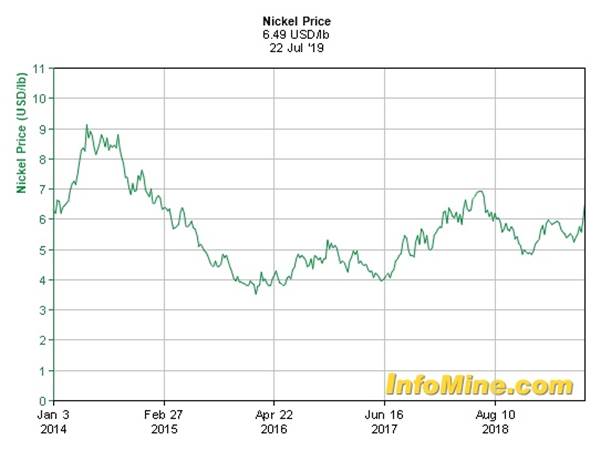
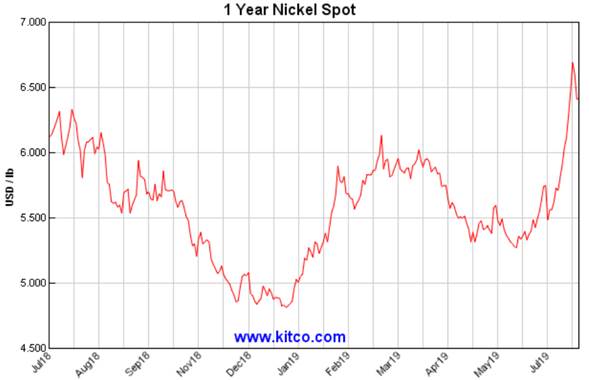
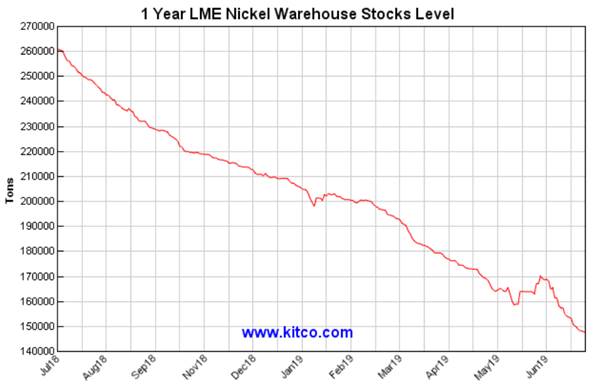
UBS believes that, because so much of the nickel market goes toward NPI and ferronickel - an alloy of nickel and iron used in stainless steel production - barring a dramatic shift to battery-grade nickel production, there will not be enough battery nickel to go around.
“The key conclusion is that mine supply growth that has occurred & likely to occur for the next few years is in a form that is inadequate to supply the battery supply market,” states UBS.
Wood Mackenzie agrees:
“Although the capacity to produce nickel sulphate (the primary starting material for NCM or NCA) is expanding rapidly, we cannot yet identify enough NiSO4 [nickel sulfate] capacity to feed the projected battery forecasts.” The research firm adds that, even if large producers like BHP switch over, “the question remains as to whether or not there will be enough nickel units left over to feed all the other segments of consumption.”
S&P Market Intelligence estimated in its report on nickel and EV batteries, that “mined nickel supply will grow 12% from 2017 to 2020. However, we forecast that mined supply suitable for battery manufacture will only grow 2% over this period,” leaving a 10% supply gap in battery-grade nickel.
Wood Mackenzie predicts nickel prices will head back up to over $US15,400, before rocketing towards $US21,000 a tonne by 2025.
Macquarie is forecasting a 20 per cent rise in the nickel price over the next 12-months to around $US15,000 a tonne, and then up again to $US17,000/t in 2021.
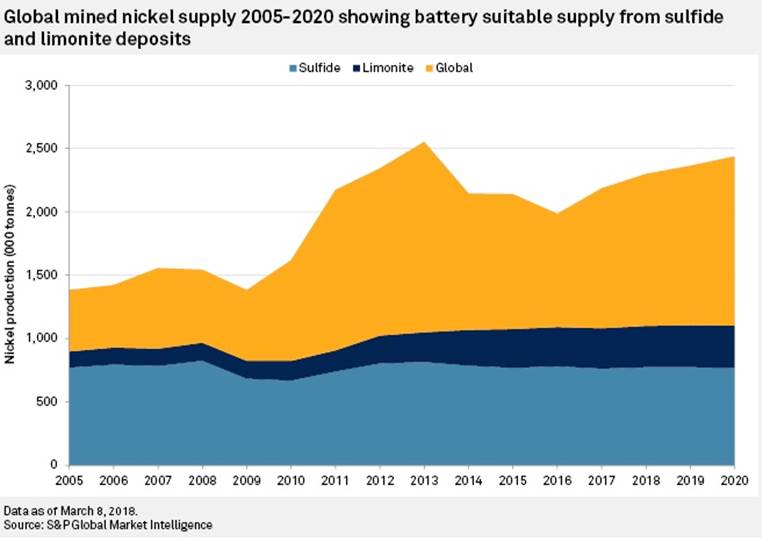
Most analysts suggest the loser in all of this future demand for nickel will be cobalt, different compositions of which are used in both NMC and NCA batteries.
“The shift to lower cobalt NMC cathodes will reduce cobalt use by up to 70% by early next decade (holding prices equal),” states UBS.
Cupboard is bare
Where will mining companies look for these new sulfide deposits, from which the extraction of high-grade nickel needed for battery chemistries is economically and technically currently feasible? The pickings are slim.
Decades of under-investment equals few new large-scale greenfield nickel sulfide discoveries. Since 1990, the only large discoveries that have occurred, happened when exploration was going on for other metals: For Voisey’s Bay it was diamond exploration, Kabanga was gold and when Enterprise was discovered they were looking for copper. We don’t believe projects like Kabanga are going anywhere given the jurisdictional risks of being in Tanzania at the border of Burundi.
Remember, only one nickel sulfide deposit has been discovered in the past decade, Nova-Bollinger in Western Australia. Capital expenditures on nickel projects plummeted from $7 billion in 2012 to $2 billion in 2017.
The result of such limited nickel exploration is a very limited pipeline of new projects, especially lower-cost sulfides in geopolitically safe mining jurisdictions.
Consider: In 2001 before the run-up in nickel prices, there were 12 projects in the nickel “cupboard” that could easily supply nickel demand. at the time, nickel sulfate for electric vehicles wasn’t even on the radar. The number of projects totaling over 500,000 tonnes of nickel included ferronickel, HPAL laterite and sulfide mines. Almost all of it went to stainless steel.
Fast forward to 2017, and the project cupboard is practically bare - just four projects over 20,000 tonnes each - Weda Bay (laterite) and Dumont, Enterprise and Kabanga (sulfide).
Conclusion
Cobalt prices hit a 10-year peak last April, prompting many end-users to consider reducing their cobalt usage. This has led to some speculation that cobalt’s days are numbered, for being too expensive a battery metal. Researchers and end users are working on ways to reduce the amount of cobalt in lithium-ion batteries.
However, all the commentaries we have read point to the conclusion that cobalt is not on the way out. An editorial in The Northern Miner states that “despite the cobalt obituaries, there is an undeniable reality here: while battery manufacturers are indeed optimizing their chemistries, research suggests there simply isn’t an easy solution to eliminating cobalt from a lithium ion cell without a trade-off, such as performance or safety. Combine this with projected growth in other sectors that use cobalt (think jet engines and samarium-cobalt magnets in the electric motors of our new electric vehicles) and forecasted demand for cobalt is as robust as it has been for many years, if ever.
The editorial goes on to say that it is highly likely that lithium-ion batteries containing cobalt will power EVs for the next five to 10 years at least. Among the reasons to continue using it, are its relative abundance, its high energy density and its stability in the cathode metals mix. The author notes high-nickel-content batteries currently being pursued “have shown greater susceptibility to thermal runaway and overheating”, as does an NCA battery employed by Tesla whose cobalt content has dropped from 13% to just 3%.
The editorial also observes that cobalt rose to $50/lb in 2008 on the rapid spread of smart phones, but, did not result in cobalt being discontinued from phones, nor did it lead to a drop in the popularity of the now-ubiquitous hand-held devices.
Simon Moores of Benchmark Minerals agrees the metal “will not be engineered out of a lithium-ion battery in the foreseeable future,” despite attempts by car-makers to reduce cobalt content in their EVs.
Remember too that 98% of cobalt is sourced as a by-product of copper or nickel. That makes cobalt actually more plentiful than nickel sulfides which are about as common as hen’s teeth.
According to the USGS, while nearly half of the world’s cobalt, 3.4 million tonnes out of a total 6.9Mt of reserves, is in the troubled DRC, the critical metal is also found in abundance in Australia (1.2Mt), Cuba, the Philippines, Russia, Morocco and Madagascar.
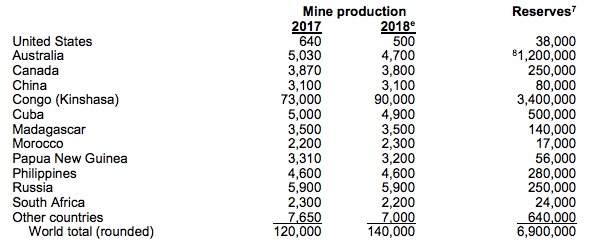
With the majority, about 70%, of your refined nickel going towards stainless steel, and the rest to other uses, like other steel alloys and nickel coins, trying to carve out a niche for battery-grade nickel is going to steal market-share from these other uses - thus driving up nickel prices.
Let’s discuss the elephant in the room. China controls over 50% of the world’s supply of lithium, they control rare earth refining, they refine 100% of the world’s graphite and they refine at least 60% of the world’s cobalt. Bottom line – China, with the help of the DRC, controls most of the world’s supply of cobalt based lithium-ion batteries.
So now lithium-ion battery manufacturers want to lessen cobalt use for the reasons discussed above. Great.
Remember I said earlier in the article “Chinese battery manufacturers are looking to migrate to nickel-containing batteries…”
If China’s Tsingshan’s vinegar into wine story works, China, with the help of Indonesia, will control nickel sulphide battery chemistry production – because they will control most of the nickel sulphide refining necessary to make battery grade material – same as they do with lithium, REEs, graphite and cobalt.
Indonesia and the DRC are eerily similar concerning resource extraction. On again off again in-country benefaction plans, shortages of electricity, export bans, increasing taxes and required state participation. Both are countries where resource nationalism has time and again reared its ugly head. And of course, the most glaring similarity between both countries is Chinese involvement in their respective resource sectors and economies.
China has been locking up supply of the critical metals needed for the electrification of the global transportation system. And just as important China has been building the necessary refining capabilities needed to turn out the advanced batteries and magnets so necessary. The west is going to be forced to play catch up.
At Ahead of the Herd we believe both cobalt and nickel sulphide will share the EV battery limelight. However, because of the scarcity of nickel sulphide deposits the junior resource company that already owns, and can develop a nickel sulfide deposit at tidewater, with enough scale to actually become a mine, will have major base metal mining companies like BHP, Vale, Glencore and Sherritt pounding on its door.
By Richard (Rick) Mills
If you're interested in learning more about the junior resource and bio-med sectors please come and visit us at www.aheadoftheherd.com
Site membership is free. No credit card or personal information is asked for.
Richard is host of Aheadoftheherd.com and invests in the junior resource sector.
His articles have been published on over 400 websites, including: Wall Street Journal, Market Oracle, USAToday, National Post, Stockhouse, Lewrockwell, Pinnacledigest, Uranium Miner, Beforeitsnews, SeekingAlpha, MontrealGazette, Casey Research, 24hgold, Vancouver Sun, CBSnews, SilverBearCafe, Infomine, Huffington Post, Mineweb, 321Gold, Kitco, Gold-Eagle, The Gold/Energy Reports, Calgary Herald, Resource Investor, Mining.com, Forbes, FNArena, Uraniumseek, Financial Sense, Goldseek, Dallasnews, Vantagewire, Resourceclips and the Association of Mining Analysts.
Copyright © 2019 Richard (Rick) Mills - All Rights Reserved
Legal Notice / Disclaimer: This document is not and should not be construed as an offer to sell or the solicitation of an offer to purchase or subscribe for any investment. Richard Mills has based this document on information obtained from sources he believes to be reliable but which has not been independently verified; Richard Mills makes no guarantee, representation or warranty and accepts no responsibility or liability as to its accuracy or completeness. Expressions of opinion are those of Richard Mills only and are subject to change without notice. Richard Mills assumes no warranty, liability or guarantee for the current relevance, correctness or completeness of any information provided within this Report and will not be held liable for the consequence of reliance upon any opinion or statement contained herein or any omission. Furthermore, I, Richard Mills, assume no liability for any direct or indirect loss or damage or, in particular, for lost profit, which you may incur as a result of the use and existence of the information provided within this Report.
© 2005-2022 http://www.MarketOracle.co.uk - The Market Oracle is a FREE Daily Financial Markets Analysis & Forecasting online publication.



